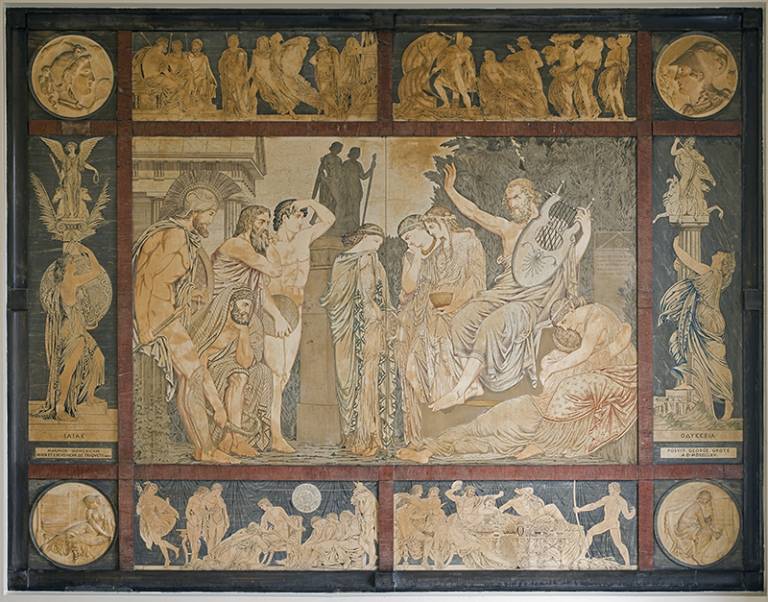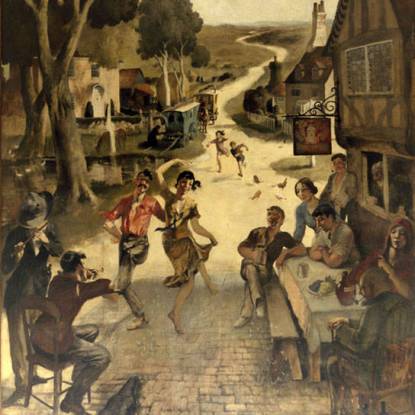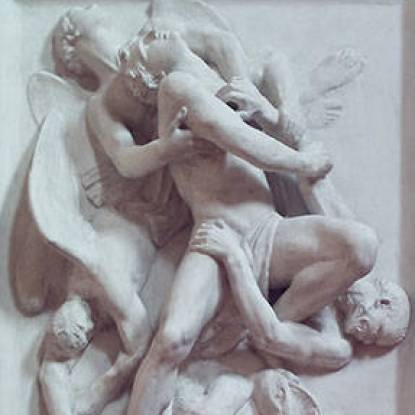Marmor Homericum
Location: Maintained in its original location in the north wall of the South Cloisters of the Wilkins Building.

The inhabitants of Delos listen spellbound as Homer recites the Illiad in this work commissioned by George Grote, one of UCL’s founders.
Completed in marble intarsia, an inlaying of coloured stones into white or black marble first made popular in the 15th Century (St. Peter’s Basilica in Rome contains some excellent examples), the Marmor Homericum remains in the South Cloisters of the Wilkins Building where it was first created and installed under the auspices of George Grote, the then Treasurer, who went on to be President of the University.
The work depicts Homer, seated at the right of the image, reciting the Iliad to the accompaniment of a lyre. The maidens of the temple of Delos listen raptly and sorrowfully, heads bowed. On the far right, two female figures embrace, comforting each other. Male figures to the left of the image include an athlete and a warrior wearing a helmet.
The work is in the Neo-classical style pioneered by John Flaxman, in which the bodies and faces of the figures are described with powerful contours, in emulation of classical statuary.
George Grote’s gifts to UCL
George Grote, a banker and philanthropist was a friend of Jeremy Bentham and a supporter of his philosophical and political ideas. He was involved with the University of London from its earliest days. It was at his house that the founders met to discuss their plans, and from 1825 to 1830 he was a member of the University Council. After a decade as Member of Parliament for the City of London he resumed his seat of the Council of the (renamed) University College in 1849. In 1860 he became Treasurer and in 1868 President of University College. He was also Vice-Chancellor of the Senate of the University of London from 1862 and trustee of the British Museum from 1859. Alongside these public offices he was also a distinguished scholar and gained public renown for his twelve-volume History of Greece (1846-56).
Grote’s lifetime gift to UCL was the commissioning in 1863 of the Marmor Homericum. Following Grote’s death in 1871, Mrs. Grote offered his collection of prints and drawings to the college. The gift was intended for the use of students at the newly established Slade School of Fine Art, and in the 1873-4 session a Fine Arts Library containing the Grote collection and other works was established for the use of Slade students.
Henri Triqueti (c.1803 – 1874)
A French sculptor and designer who found great success both at home and in England, Henri Triqueti was born in Conflans, Loiret not far from Orléans. He was the son of a Piedmontese industrialist and diplomat and had a privileged and cultured upbringing. Encouraged by his family friend, the painter Anne-Louis Girodet , he went on to study under Louis Hersent , who had been a pupil of Jacques-Louis David – all of which gave him a solid grounding in the Neo-Classical tradition. Triqueti received his inspiration from early Renaissance Italian sculpture rather than the Neo-classical leanings of the contemporary École des Beaux-Arts.
Triqueti exhibited in The Salon from 1831 onwards, receiving a medal for sculpture at his debut show. He won the commission to design the bronze doors of the Église de la Madeleine , in Paris in 1834.
In 1848, he was injured at the famous barricades of the French Revolution. On recovering he sought refuge in England and found success here. In one of his most notable commissions, Queen Victoria commissioned him to collaborate with Sir George Gilbert Scott on transforming the Wolsey Chapel at Windsor Castle into the Albert Memorial Chapel
 Close
Close




